

Wild Medicinal Plants Archives. Attention Wild Food Aficionados: Fall foraging forges forward, and by that alliteration I mean to say that foraging for wild food “has not yet ended” this fall, so don’t put away your scissors or your plastic knives or your bare hands just yet!
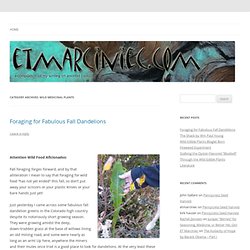
Just yesterday I came across some fabulous fall dandelion greens in the Colorado high country despite its notoriously short growing season. They were growing amidst the deep, down-trodden grass at the base of willows lining an old mining road, and some were nearly as long as an arm! Up here, anywhere the miners and their mules once trod is a good place to look for dandelions. At the very least these early travelers toted the seeds along by accident. Continue reading Heads up, blog readers, especially those of you interested in wild edible plants–I have an exciting announcement to make! New Wild Food Girl site: What happens to the old content? In the meantime, thanks so much for reading and I hope to hear from you over at wildfoodgirl.com.
-Erica. Free Wild Plant Identification eCourse. You are out in the forest and looking at the glorious plant life surrounding you.

Whether you are a beginner and have never identified one plant, or a Botany professor at a university, you might appreciate this refreshingly simple approach to plant identification. I remember lovingly (and sometimes screamingly) that my college classes in Systematic Botany required me to become acquainted with that local Washington Flora that we plant dorks call “Hitchcock and Cronquist”. I always felt a contradiction of rapt fascination and obsession, alternated with profound burnout, when trying to navigate this enormous dichotomous key! In addition, my observation skills as an ethnobotanist were refined , foraging for wild foods, fibers and medicine.
After many years of this love affair with plants, I learned a new way to proceed in my plant identification journey that added a much-needed holistic element. What will I need? Meet a Plant Approach the plant of your choice and find a place to start. Wildcrafting.net: Foraging Database, Edible & Medicinal Plants.
Plant Search By US State. CalPhotos SE For Plants & Fungi By Name & Region. Wildflowers: GardenWeb Index. UConn Plant Database. Identify That Plant: Master The Skill Of Plant Identification. Plants Database. Herbal Directory: Penn State Univ. Information on common herbs for cultivation and culinary purposes.
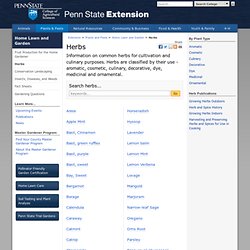
Herbs are classified by their use - aromatic, cosmetic, culinary, decorative, dye, medicinal and ornamental. Important Disclaimer The information shared freely on these pages is meant for cultivation of the crops and for culinary use only. Other uses are simply noted, so that readers are aware that they exist. They should research these herbs on their own for risks, dosages, concerns, etc., particularly if these are intended for any medicinal treatments. Contact Michael Orzolek, Professor of Vegetable Crops The Herb directory was developed by Keppy Arnoldsen, Aimée Voisin and Jen Johnson under the guidance of Dr. Tree Identification Guide At Arborday. Wildflowers & Weeds: Learn To Identify Wildflowers With Botany In A Day. Wild Flower Identification Guide (ID Guide)
Poisonous Plants Basics. Plants are amazing creatures that produce many great benefits for human consumption.

We get most of our medicines from plants, our foods and even our beauty products. Still, there are poisonous plants among the wild edible plants that people need to be aware of when it comes to consuming them. Non-Edible Poisonous Flowers Chart. Non-edible Poisonous Flowers This chart is a list of the most commonly-known poisonous plants and flowers to avoid while selecting edible flowers.
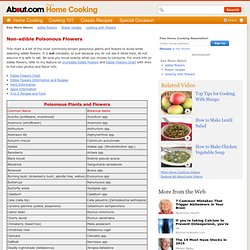
It is not complete, so just because you do not see it listed here, do not assume it is safe to eat. Be sure you know exactly what you choose to consume. For more info on edible flowers, refer to my feature on Incredible Edible Flowers and Edible Flowers Chart with links to full-color photos and flavor info. • Edible Flowers Chart • Edible Flowers Information and Recipes • Herb Information • Spice Information • A to Z Recipes and Food. Top 10 Most Dangerous Plants In the World. 1. Most likely to eat a rat Giant Pitcher Plant: Nepenthes attenboroughii Discovered more than 5000 feet above sea level on Mount Victoria in the Philippines, the giant, carnivorous pitcher plant secretes a nectar-like substance to lure unsuspecting prey into a pool of enzymes and acid.
A series of sticky, downward ribs makes it nearly impossible for trapped prey to escape. Botanicus: Library Of Historic Botanical Literature. Poisonous Plants 1. Successful use of plants in a survival situation depends on positive identification.
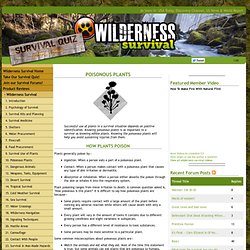
Knowing poisonous plants is as important to a survivor as knowing edible plants. Knowing the poisonous plants will help you avoid sustaining injuries from them. Plants generally poison by-- Poisonous Plants 2. Plants basically poison on contact, ingestion, or by absorption or inhalation.

They cause painful skin irritations upon contact, they cause internal poisoning when eaten, and they poison through skin absorption or inhalation in respiratory system. Many edible plants have deadly relatives and look-alikes. Wild Plant Stock Photos - Wild Food School. Digital images used in the course of WFS activities over the lastfew years are now being made available online.
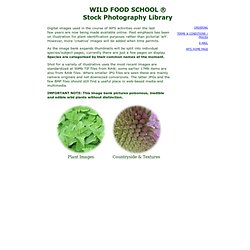
Past emphasis has been on illustration for plant identification purposes rather than pictorial 'art'. However, more 'creative' images will be added when time permits. As the image bank expands thumbnails will be split into individual species/subject pages; currently there are just a few pages on display. Silvics Manual: Guide To N. American Tree Species. Russell M.

Burns and Barbara H. Honkala Technical Coordinators Timber Management Research Agriculture Handbook 654 (Supersedes Agriculture Handbook 271, Silvics of Forest Trees of the United States, 1965) Forest Service United States Department of Agriculture Washington, DC December 1990 Burns, Russell M., and Barbara H.